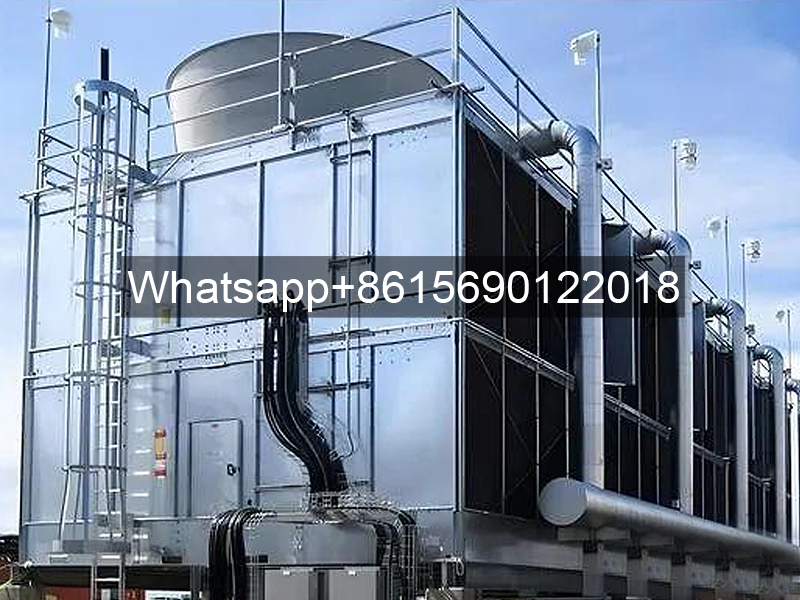Eu. Definition and Working Principle
Evaporative Condenser
An evaporative condenser is a type of condenser and the primary heat exchange device in a refrigeration system. It uses the instantaneous heat absorption of water molecules during evaporation to reduce the temperature of the high-temperature, high-pressure gas refrigerant discharged from the compressor and convert it into liquid refrigerant.
Condenser Working Principle: The high-temperature gaseous refrigerant exchanges heat with the spray water and air outside the discharge pipe. The spray water partially transforms into a gaseous state. The wind then uses the water’s latent heat of vaporization to carry away a significant amount of heat, thus achieving condensation.

Cooling Tower
A cooling tower uses contact (direct or indirect) between air and water to cool water. Using water as the circulating coolant, it absorbs heat from a system and releases it to the atmosphere, thereby lowering the temperature within the tower and creating a recyclable cooling water system.
Working Principle: Hot water in the cooling tower exchanges heat with the cooler air flowing over the water’s surface. The water transfers heat to the air, which then carries it away and dissipates it into the atmosphere. There are three main ways water dissipates heat to the air: contact heat dissipation, evaporation heat dissipation, and radiation heat dissipation (however, radiation heat dissipation is very small and can be ignored).
II. Structure and Components
Evaporative Condenser
It mainly consists of a cooling water circulation system, a refrigerant circulation system, and an electrical control system.
The cooling water circulation system includes a spray tank, a water pump, and a fan.
The refrigerant circulation system includes an evaporator, a condenser, a compressor, and other components.
The electrical control system includes a control cabinet, temperature sensors, a water level switch, and other components.
Cooling Towers
Typically, they are tower-shaped structures containing components such as packing, a fan, and a spray system.
The packing increases the contact area between water and air, improving heat dissipation.
The fan forces air flow, accelerating heat exchange between water and air.
The spray system evenly sprays water onto the packing, forming a water film or droplets that facilitate heat exchange with the air.
III. Applications and Selection
Evaporative Condensers
Commonly used in cold storage construction, central air conditioning, and other refrigeration facilities. When selecting a cooling tower, consider parameters such as the refrigerant type, operating pressure, and condensing temperature.
Cooling Towers
These are generally considered large-scale refrigeration equipment used in industrial applications using water cooling.
When selecting a cooling tower, consider parameters such as the cooling water flow rate, temperature, and water quality, as well as structural parameters such as the tower’s height, diameter, and fan power.
IV. Other Differences
Cooling Medium in Tubes
Cooling Towers: Use water.
Evaporative Condensers: Use other refrigerants.
System Piping
Evaporative condensers connect to closed systems with a certain level of pressure.
Cooling towers can connect to closed or open circuits, operating at low or no pressure.
Evaporative condensers and cooling towers differ significantly in their definition, operating principle, structure and composition, application areas, selection, and other aspects. Therefore, comprehensive considerations are required when selecting and using a cooling tower based on the specific application scenario and requirements.
V. Advantages and Disadvantages of Each Type
Evaporative Condenser
Advantages of Evaporative Condensers:
Energy-saving and environmentally friendly: Evaporative condensers cool the system by absorbing heat through the evaporation of water, eliminating the need for refrigerants. Consequently, they consume less energy and offer excellent environmental performance.
Good Cooling Performance: Evaporative condensers can reduce the condensing temperature of the condensing system by 6–8°C, significantly reducing energy consumption and typically saving over 10% or even 30% of power consumption.
Low Maintenance Cost: Due to their compact structure and the fact that most components are made of stainless steel or galvanized steel, maintenance costs are low.
Water-saving: Evaporative condensers consume only 5–15% of the water of cooling tower systems, conserving water resources.
Small Footprint: Evaporative condensers are compact, saving space.
Disadvantages of Evaporative Condensers:
Limited Application Scenarios: Evaporative condensers are less effective in humid climates, are prone to bacterial growth, and impurities in the water can easily clog the equipment.
High Equipment Complexity: Although compact, its operating principles are relatively complex and require specialized maintenance personnel.
Cooling Towers
Cooling Tower Advantages:
Wide Applicability: Cooling towers are suitable for a variety of climates, operating effectively in both dry and humid areas.
High Efficiency: Cooling towers offer excellent heat dissipation and can utilize various water circulation methods as needed, resulting in high efficiency.
Long Equipment Life: Chemical agents can be added to prevent scale and fouling, extending equipment life.
Cooling Tower Disadvantages:
Complex Equipment: Cooling towers involve multiple components, including pumps, radiators, cooling towers, and water tanks, resulting in high maintenance costs.
High Maintenance Costs: Due to the complexity of the equipment, specialized maintenance is required, increasing maintenance costs.
High Water Consumption: Cooling towers require large amounts of water and have high requirements for water purity and temperature.
 dtfinnedtube.com
dtfinnedtube.com

